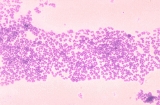
Micrococcus
Overview
Genus
In biology, a genus is a low-level taxonomic rank used in the biological classification of living and fossil organisms, which is an example of definition by genus and differentia...
of bacteria
Bacteria
Bacteria are a large domain of prokaryotic microorganisms. Typically a few micrometres in length, bacteria have a wide range of shapes, ranging from spheres to rods and spirals...
in the Micrococcaceae
Micrococcaceae
The family Micrococcaceae includes bacterial genera of Gram positive cocci that inhabit the air and skin such as Micrococcus luteus.-External links:* * J.P. Euzéby's...
family
Family (biology)
In biological classification, family is* a taxonomic rank. Other well-known ranks are life, domain, kingdom, phylum, class, order, genus, and species, with family fitting between order and genus. As for the other well-known ranks, there is the option of an immediately lower rank, indicated by the...
. Micrococcus occurs in a wide range of environments, including water, dust, and soil. Micrococci have Gram-positive
Gram-positive
Gram-positive bacteria are those that are stained dark blue or violet by Gram staining. This is in contrast to Gram-negative bacteria, which cannot retain the crystal violet stain, instead taking up the counterstain and appearing red or pink...
spherical cells ranging from about 0.5 to 3 micrometers in diameter and are typically appear in tetrads. Micrococcus has a substantial cell wall
Cell wall
The cell wall is the tough, usually flexible but sometimes fairly rigid layer that surrounds some types of cells. It is located outside the cell membrane and provides these cells with structural support and protection, and also acts as a filtering mechanism. A major function of the cell wall is to...
, which may comprise as much as 50% of the cell mass. The genome of Micrococcus is rich in guanine
Guanine
Guanine is one of the four main nucleobases found in the nucleic acids DNA and RNA, the others being adenine, cytosine, and thymine . In DNA, guanine is paired with cytosine. With the formula C5H5N5O, guanine is a derivative of purine, consisting of a fused pyrimidine-imidazole ring system with...
and cytosine
Cytosine
Cytosine is one of the four main bases found in DNA and RNA, along with adenine, guanine, and thymine . It is a pyrimidine derivative, with a heterocyclic aromatic ring and two substituents attached . The nucleoside of cytosine is cytidine...
(GC), typically exhibiting 65 to 75% GC-content
GC-content
In molecular biology and genetics, GC-content is the percentage of nitrogenous bases on a DNA molecule that are either guanine or cytosine . This may refer to a specific fragment of DNA or RNA, or that of the whole genome...
.
Unanswered Questions

